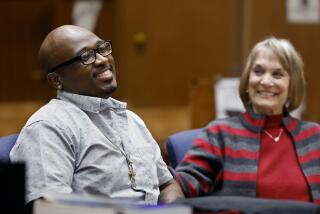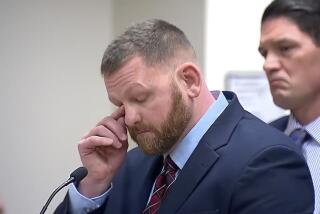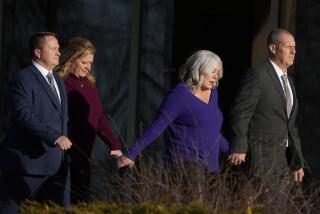A landmark conviction of a Chicago policeman — and a city’s sigh of relief
With an entire city watching, convicted murderer Jason Van Dyke was taken into sheriff’s custody Friday and escorted from the courtroom.
And Chicago exhaled.
Businesses closed early and commuters scurried out of downtown, but the feared riots never materialized. Protests, too, remained peaceful.
And inside the courthouse, the special prosecutor who won Van Dyke’s conviction predicted Chicago would heal from the wounds inflicted by the video-recorded shooting death of 17-year-old Laquan McDonald at the hands of the Chicago police officer.
Because this case was never about one cop.
Police scandals in Chicago have come and gone. But since the court-ordered release of a police dashboard camera video showing Van Dyke shooting McDonald as he walked down a street holding a knife, the city has faced a political and social reckoning unlike any in recent decades.
Police Supt. Garry McCarthy was fired. Voters ousted Cook County State’s Atty. Anita Alvarez. Mayor Rahm Emanuel opted not to run for reelection.
Three other Chicago police officers have been charged with conspiring to cover up what really happened on Pulaski Road on the night of Oct. 20, 2014, and are due to go on trial late next month. In addition to that criminal case, the Police Department now faces federal oversight following a U.S. Department of Justice investigation into the shooting.
The video galvanized the city’s activist community, many of whom vowed to maintain their momentum following Van Dyke’s conviction.
“The buck stops here,” said activist William Calloway, who was instrumental in the video’s release. “The buck stops in Chicago.”
A Cook County jury convicted Van Dyke of second-degree murder and 16 counts of aggravated battery with a firearm in connection with McDonald’s death. The verdict marked the first time in more than 50 years that a Chicago police officer has been convicted of murder for an on-duty incident.
In reaching their decision, jurors relied heavily on the dash-cam video that showed Van Dyke, who is white, firing 16 shots at McDonald, who is black and who appeared to be walking away from officers. Though race was not explicitly mentioned during the testimony, some witnesses made subtle references to skin color.
Special prosecutor Joseph McMahon stunned many in his opening statement when he accused Van Dyke of shooting McDonald because he was a “black boy” who had the audacity to ignore the police.
McMahon, the state’s attorney in suburban Kane County who was appointed because of Cook County prosecutors’ conflicts of interest, told reporters after the verdict that he believed it would have been wrong to ignore the long and fractured history between minority communities and the Chicago Police Department.
“None of us looked at this case and did not understand that there is an element of race in this conversation,” he said. “That issue has permeated the relationship between law enforcement and many communities. I think it was important to talk about what was honest here. That’s why I said it.”
McMahon said the McDonald shooting and the conversations it started could ultimately help the city heal.
“The verdict marks an opportunity for this city to come together,” he said.
Healing, however, may take some time. Representatives of the state and local police unions condemned the verdict — with the president of the Illinois Fraternal Order of Police even saying that jurors had been “duped.”
“This is a day I never thought I’d see in America, where 12 ordinary citizens were duped into saving the asses of self-serving politicians at the expense of a dedicated public servant,” President Chris Southwood said in a statement. “What cop would still want to be proactive fighting crime after this disgusting charade, and are law-abiding citizens ready to pay the price?”
But many jurors told reporters that the responsibility felt like a privilege. They described their deliberations as respectful and harmonious.
“Every morning I got on the bus and on the train, and I saw hundreds and hundreds of my fellow Chicagoans, and I thought, how did I get on this jury?” one male said. “There are all these people, and I’m doing this work and nobody knows it. It felt really amazing.”
Most jurors agreed to speak with reporters in the courtroom after the hearing, but did not consent to releasing their names. They spoke seated in the jury box with Judge Vincent Gaughan looking on from the bench.
The foreperson, a white woman, said she knew before she was selected for jury service that the case had drawn national and local attention. She had to discipline herself to consider only the evidence at hand rather than her knowledge of the outside circumstances — for example, why certain officers were testifying under immunity from prosecution.
But what really brought home her sense of “profound duty,” she said, was seeing the faces in the courtroom every day.
“I know I wasn’t sleeping for three weeks. I was thinking of it constantly because of its impact,” she said. “Every day we walked in and looked at two families. We saw Jason Van Dyke’s family, and we saw Laquan McDonald’s family. And I couldn’t walk in here without thinking about that every day.”
The case largely boiled down to the video that depicted the shooting as it unfolded as well as Van Dyke’s testimony in which he defended his actions.
The video, played dozens of times for jurors over the month-long trial, showed Van Dyke and his partner pulling up to the scene as McDonald walked south in the middle of Pulaski Road, holding a 3-inch folding knife. As their car got to about 20 feet from McDonald, Van Dyke opened the passenger door for a brief moment before his partner, Joseph Walsh, pulled up farther down the street. Both jumped out with their guns drawn.
Six seconds after Van Dyke exited the car, he took a step toward McDonald — closing the distance to about 12 feet as the teen continued to walk at an angle away from him — and opened fire. McDonald spun and fell to the pavement, his body making only small movements as more bullets appeared to strike him.
Van Dyke continued firing for at least 12 seconds while McDonald lay prone in the street, emptying all 16 rounds into his body, prosecutors said.
Van Dyke told the jury that he was forced to make a split-second decision to shoot McDonald because the teen posed a threat and ignored commands to drop the knife.
Jurors found Van Dyke’s testimony rehearsed and unconvincing. Some even questioned whether his tears on the stand were genuine.
“His memory and the facts in evidence didn’t line up,” said one juror, a white man.
Hours after the conviction, the Chicago Police Board released a statement reminding the public that Van Dyke and four fellow officers still face possible firings.
While Van Dyke’s trial focused on his actions alone, a trial set for next month could have a much broader sweep — putting the alleged police “code of silence” on trial.
Three of Van Dyke’s fellow officers will face trial on charges that they conspired to cover up the circumstances surrounding the shooting.
Crepeau, Gutowski, Meisner and St. Clair write for the Chicago Tribune.
More to Read
Start your day right
Sign up for Essential California for news, features and recommendations from the L.A. Times and beyond in your inbox six days a week.
You may occasionally receive promotional content from the Los Angeles Times.






